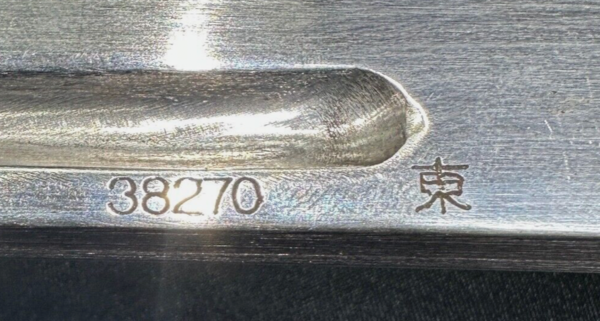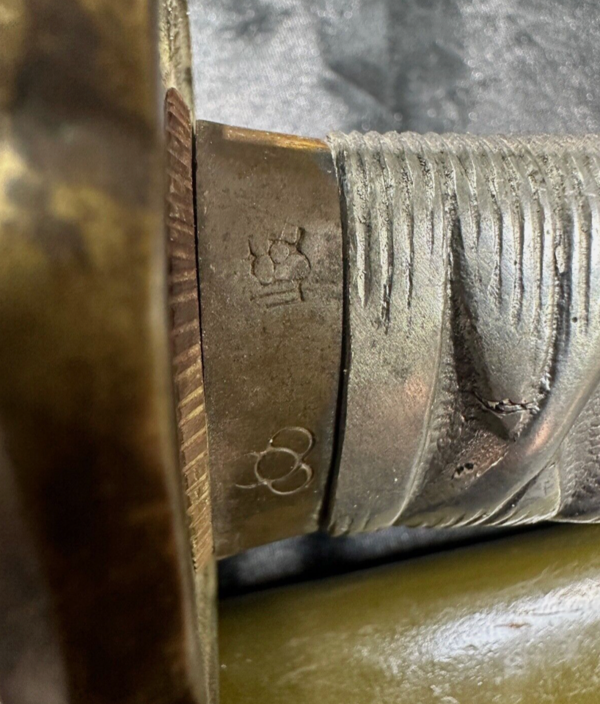
John C
Members-
Posts
2,516 -
Joined
-
Last visited
-
Days Won
16
Content Type
Profiles
Forums
Events
Store
Downloads
Gallery
Everything posted by John C
-
Wow. You guys never cease to amaze. There is no way I could have figured that out. Much appreciated. John C.
-
Hello: I'm not sure if the marks on these yatate are writing or just scribble. Not sure if it is in the right orientation, either. Best pic I have at the moment. Any help would be appreciated. John C.
-
Steve: In that one particular auction from Eric you referenced above, he mentions the word "minty" 9 times in the description, though he is not selling mouthwash. He also uses the word "samurai" in the title when he knows perfectly well it was not and could not have been used by a samurai warrior. As Bruce noted above, sellers use words that attract unknowledgeable buyers to increase viewer traffic. So his use of NLF and other words are for marketing only. This is the "overly loose" use of words to attract buyers. Hope this helps, John C.
-
This does not look real to me, however I was unaware type 8/19s were faked. https://shopgoodwill.com/item/191940374 John C.
-
Hello: For anyone who collects yatate or other type of sagemono, have you seen this large style before? I have it pictured with a "normal" size yatate. Could this be an over-sized tourist piece; a "desktop" model/paperweight; a store sample/display?? It's a beast (12 inches long, 3 inches tall, and over a pound), made of bronze or brass. I can't imagine anyone carrying this tucked in an obi. Doesn't appear to have been used and is not marked. If you know, please let me know! Regards, John C.
-
I'm not an expert, however it seems fake to me as well - the "grinder" style bohi; the dremel nagoya mark; the poorly faked fuchi stamps, etc. John C.
-
Hello: According to google app, the phrase is "framed inscription." As to general info on origami, here is a good reference: http://www.nihontocr...se_sword_papers.html John C.
-
New member beginning the journey.
John C replied to Avidmark's topic in General Nihonto Related Discussion
If it is Nihonto you are interested in, a good and reasonable jumping off point would be The Connoisseur's Book of Japanese Swords (currently 47.75 USD on Amazon). https://www.amazon.c...Swords/dp/1568365810 This book will give you a good overview of the different schools, hamon, hada, etc. John C. -
Has this been posted before? Note the bohi is cut correctly, however... https://www.ebay.com/itm/404570728906?hash=item5e324b69ca:g:hSgAAOSwutNlOCRI&amdata=enc%3AAQAIAAAA4GxONsz2BNSqFK0i9CJoVwADl8lBLhdjwJvBeazvW%2FKlrzxe3wejxQKP5AKkNbOX7QoC8IE2OBLY6zrvR4GghmoJAOH0dXmFzw2G1zwKfEUbjR9U6bmA4kTqQPhivhPdlsl%2FHFO0wfydGpJumc2MjnFyb3NkaIrIISSQLFedgU0gU%2F51Put%2B2PEFen160gRWUjHDzQrQOzmSezQd5uiP6Buk5hb%2F1%2BpHV6Az23Uc2v1i8%2BJCnF9Lrv8Q42vFxzZ7Jscmc6ThXTKNQiXuGHpvw%2BIFlZUOX%2FllRJbusCGZv4xN|tkp%3ABk9SR4DliNKeYw John C.
-
As far as a "fake" kaigunto, not sure I have seen one (though I am sure others have). But look at the differences between an actual kaigunto and souvenir swords that are VERY often passed off as original kaigunto. In addition, there are differences between iron tsuba. They look similar, however the souvenir version is larger than the type 3 version; whereas the kaigunto has rays on it. John C.
-
Help in identifying the image of the plant.
John C replied to gorec5642's topic in Military Swords of Japan
John C. -
Also, while the blade is probably older than WW2, the shirasaya is of the style and type that would have been produced and carried in WW2. So possibly someone carrying an older blade during WW2. Below is a pic of one with a war-time blade. John C.
-
A question on Yari spear tip sizes.
John C replied to kusunokimasahige's topic in General Nihonto Related Discussion
Thank you for your research. I am assuming mine is not old, however I was hoping to get as close as early or late whatever century. John C. -
Can yari be dated through kantei?
John C replied to John C's topic in General Nihonto Related Discussion
Thank you both for responding. I was hoping to take a crack at dating the blade using a kantei method, however there is not a lot of info out there pertaining specifically to yari. Jussi, here is a pick, though it may not be much help. Based on the kerakubi, it's not very old Nagasa: 4.5 inches Overall: ~14.5 inches John C. -
I recently acquired a yari blade in shirasaya and was wondering if it could be roughly dated using kantei? Are yari styles indicative of a certain period or are the various styles too ubiquitous to determine age? Thank you, John C.
-
Okay so I'm a nerd. But here is a page from a book on knots talking about the cockscomb style knot work. John C.
-
Japanese Officer Sword- Iwo Jima
John C replied to montrealfan1986's topic in Military Swords of Japan
Looks like the name is trying to be Yamamoto. But I suspect not THE Yamamoto. John C. -
Haven't seen them before, however seems like the spring clip breaks easily so it makes sense. Here is one for sale. John C.
-
Japanese Officer Sword- Iwo Jima
John C replied to montrealfan1986's topic in Military Swords of Japan
The mounts appear to be Rinji Seishiki (sometimes referred to as type 3). These will generally have two mekugi (bamboo pins). Removing the tsuka is the same as other showato but with two pins. In addition, many of these came with traditionally made blades (gendaito) so it's worth a look at the nakago. John C. -
John: I don't think that red tassel is original to that sword. You could probably carefully remove it if you want the sword in a more original condition. The tassel would have most likely looked like the one below (blue and brown for company officer grade or red and brown for field grade). John C.
-
Matt: Would you be able to measure both the length and width of each tsuka (handle)? I think the comparison would be useful for future reference on the fake type 95 thread. John C.
-
A question on Yari spear tip sizes.
John C replied to kusunokimasahige's topic in General Nihonto Related Discussion
Thank you. As a follow-up, is there any way to tell an approximate age based on style/size or did the various styles run the gamut of periods? It seems to be very nicely made with nie along the temper line and is in decent polish. Nakago is a dark rust so I'm thinking not too new. Early meiji perhaps? John C. -
Are there any written or stamped marks on the wooden inserts? May indicate the shop where it was made. John C.















